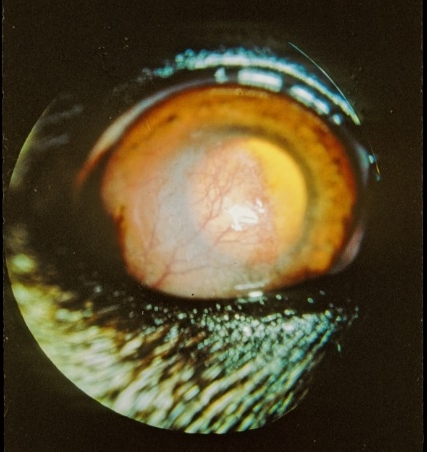Pannus
Nancy M. Bromberg, VMD, MS, DACVO
CHRONIC SUPERFICIAL KERATIS AND PLASMA CELL INFILTRATE OF THE THIRD EYELIDS
What is pannus?
Pannus is the common term for Chronic Superficial Keratitis and/or Plasma cell infiltrate of the third eyelids. Pannus is an immune-mediated problem with suspected inherited etiology most frequently identified in Shepherd breeds, Greyhounds and Dachshunds.
However, other breeds and mixed breed dogs can also be affected. Pannus occurs when there is an immune response of the eye toward (most frequently) the cornea. It frequently starts at the ventrolateral (outer and lower) aspect of the cornea and progresses across the cornea.
There is an ingrowth of inflammatory cells and vascular tissue, accompanied by pigmentation and secondary degenerative or dystrophic changes. Pannus of the third eyelid occurs due to accumulation of plasma cells and other inflammatory cells in the third eyelid, especially the leading edge. UV exposure exacerbates the syndrome.
How is pannus diagnosed?
Chronic superficial keratitis (CSK) is identified by the progressive vascular and inflammatory changes seen in the cornea. Plasma cell infiltrate, which can occur separately or in conjunction with CSK, appears as a thickened, “cobble-stone” appearance, with depigmentation of the leading edge of the third eyelid. CSK usually starts at the ventrolateral aspect of the cornea.
How is pannus treated?
Pannus is an immune-mediated ocular surface disease. Treatment utilizing topical immunosuppressant ophthalmic medications can be useful in clearing of the corneal opacification and maintenance of the corneal health. Patient with Pannus are never cured. It is imperative that treatment recommendations be followed and continued for the rest of your pet’s lifespan. In severe cases, injections of medications around the eyes or other possible surgical treatment implants can be utilized. In rare cases, Beta radiation has been used as a treatment modality to decrease blood vessels and cells in the corneal tissues.
What is the prognosis for pannus?
UV light exposure causes exacerbation of the condition. Dogs living in high-altitudes, with increased UV exposure are frequently difficult to control. Once brought under control, the prognosis is good for continued control with appropriate treatment. Your ophthalmologist will recommended rechecks at specific intervals to keep the condition under control. If medications are discontinued and the Pannus worsens, it may be more difficult to bring it under control again. There is no cure for “Pannus”- only control.
Figure 1: Plasma Cell Infiltrate of Third Eyelid
Figure 2: Chronic Superficial Keratitis


